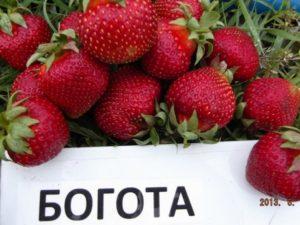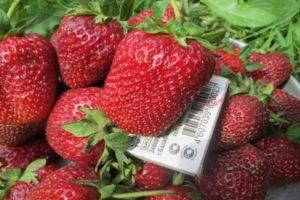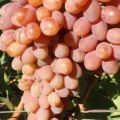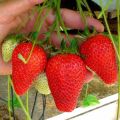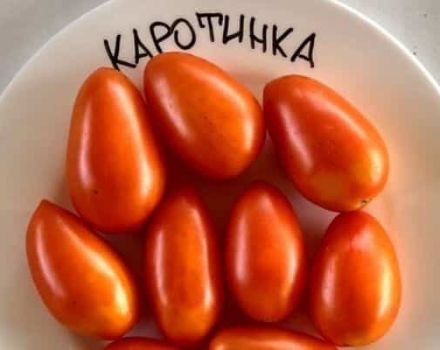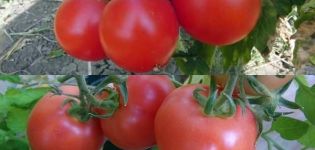Description and characteristics of Rumba strawberries, planting scheme and care
Strawberries are a favorite berry of both children and adults. Breeders have cultivated many of its varieties, different in taste, aroma, color, ripening time. The Rumba strawberry was bred by Dutch specialists, and has found wide application for its positive qualities. Further information on the advantages and disadvantages, the characteristics of cultivation, rules of care, methods of reproduction, as well as the collection and storage of Rumba.
Description of Rumba strawberry and its characteristics
Strawberry Rumba is a shrub with widely branched dark green leaves and large fruits. The weight of one dark red berry varies between 25-35 grams. The first fruits that appear on the bush are conical, the subsequent ones are rounded-conical. The root system is fibrous, abundant, which contributes to the transfer of moderate frosts.
Strawberries begin to bear fruit in early June. Rumba strawberries are sweet, with a slight sourness. They have a pleasant aroma as well as a long-lasting strawberry aftertaste. The life cycle of the bush is 3-4 years.
Advantages and disadvantages
The positive aspects of the Rumba variety include:
- early ripening;
- high yield (up to 400 grams of berries are harvested from the bush);
- frost resistance;
- dense structure of berries;
- unpretentious care;
- the ability of the variety to grow berries of the same size throughout the entire fruiting period.
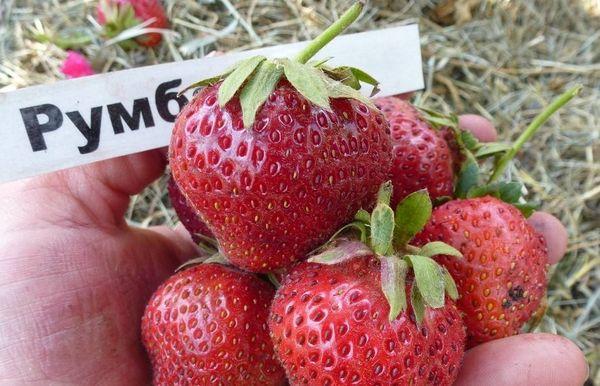
The negative qualities of the Rumba strawberry include:
- wateriness of berries after rain;
- change in taste in wet weather;
- poor resistance to disease.
Note! Under unfavorable conditions, the aroma, taste and texture of the berries change.
Features of growing a plant
Garden strawberries are planted in holes in such a way that their core is at ground level. A low planting contributes to decay and death of bushes, a high planting contributes to freezing in winter.
Boarding time
Rumba strawberries are planted on the site in spring or autumn. The earlier the culture is planted, the better it will take root before the onset of heat or frost. In spring, the procedure is performed in April, in autumn - at the beginning of September.
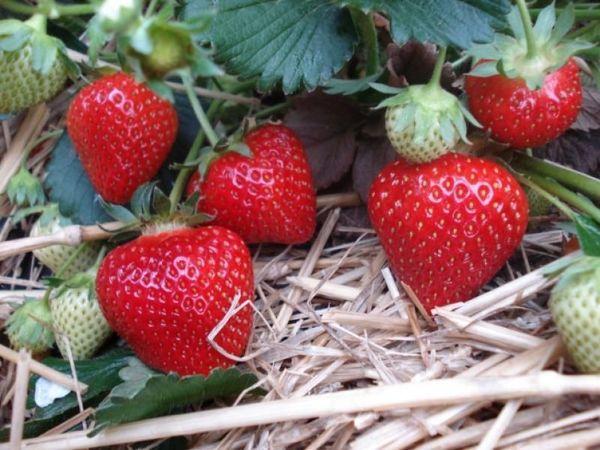
Soil and plot
The territory for planting garden strawberries is selected well-lit by the sun, ventilated. The plot is prepared long before planting the crop: it is cleared of weeds, dug up, organic matter is introduced into it at the rate of 3 buckets per 1 m². Strawberries will grow best on light loam or sandy loam with the addition of fertilizer.
Landing procedure
Before planting strawberry bushes on the site, the root system must be soaked in a solution prepared from the following components:
- 30 grams of copper sulfate;
- 10 liters of water.
The procedure will serve as disinfection, as well as prevent the appearance of fungal diseases. In addition, before planting, the lower leaves are removed, leaving no more than 4 on the bush. If the root system is more than 10 centimeters, it is pruned.
At a distance of 35 centimeters, shallow holes are dug into which water is poured. The root system is located strictly in the center of the hole, straightens out, and is covered with earth. The soil is slightly compacted, watered with water, mulched.
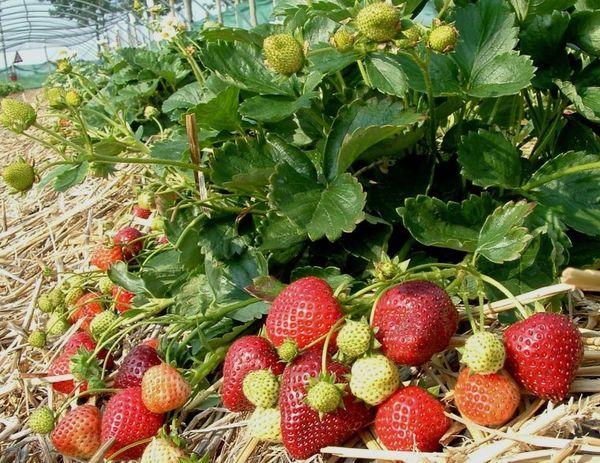
Care rules
Strawberries need to be looked after throughout the season: watering, removing weeds, fertilizing, replanting as the bush grows. So that the berry has a marketable appearance, and does not get dirty after watering or rain, the soil under the bushes can be sprinkled with sawdust.
Fertilization
Fertilizing crops are needed for abundant fruiting, as well as a favorable transfer of winter. Garden strawberries especially need potassium: it helps to increase sugar content, preserve the density of the berry. Fertilize strawberries in spring, summer and autumn.
Before carrying out the procedure, the soil is watered with plain water.
Watering
With the onset of warm weather, garden strawberries are watered abundantly. Further irrigation is carried out as needed: the land should not completely dry out, but it should not be wet all the time. Until flowers appear on the bushes, you can irrigate the soil by sprinkling, with the beginning of flowering - only from a hose under the root.

Transfer
After 3-4 years, Rumba bushes grow, and she needs a transplant. Before the procedure, the garden bed is dug up, the following fertilizers are applied to it:
- 10 kilograms of humus;
- 50 grams of potassium salt;
- 100 grams of superphosphate.
The number of components is calculated for 1 m² of the garden. The transplant procedure can be done in spring or autumn.
Diseases, pests and ways to control them
Rumba strawberries can be susceptible to various fungal and viral infections. Most often this is due to the weakening of the immune system of the bushes due to improper care. To prevent diseases, you need to carry out the following procedures:
- Remove old mulch in spring.
- To plant the plants, not allowing them to thicken.
- Remove weeds that can carry pathogenic microorganisms and pests.
- Moisten the earth moderately: due to an excess of moisture, the root system begins to rot.
- Periodically inspect the planting, removing yellow and dry leaves, as well as weakened bushes.

In addition, the bushes in the spring for prevention need to be sprayed with insecticides and fungicides. In the aisles, you can sow plants, the smell of which is not tolerated by many pests, for example, marigolds and marigolds. To improve the health of the land, siderates are sown at the site of the expected growth of strawberries.
Important! Strawberries should not be planted after raspberries, cruciferous and nightshade families.
Breeding varieties
Strawberries reproduce by division, layering (mustache), seeds. To divide the bush, they dig it up, carefully divide it into parts, plant each division in a separate hole. To breed a culture with a mustache, you need to follow these steps:
- sprinkle peat and sawdust in the aisles;
- pin the mustache of the first order to the substrate;
- care for them in the same way as for adult plants.
Grown young plants are separated from the mother plant in autumn and planted in a permanent place. In the spring they will give their first harvest.
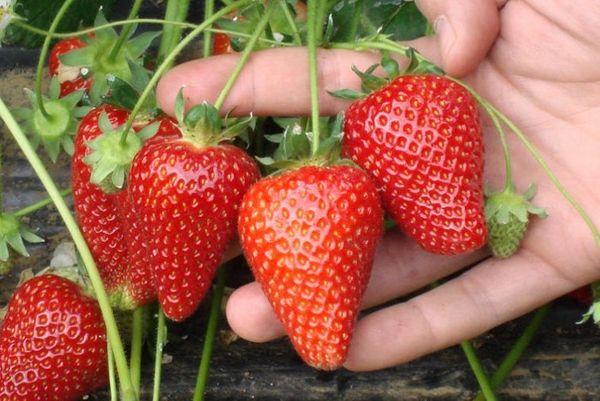
Propagation of strawberries by seeds is as follows:
- seeds are soaked in a solution of any growth enhancer;
- the container is filled with loose soil, on the surface of which small strawberry seeds wake up;
- seed material is sprayed with water from a spray bottle, the container is covered with glass;
- after 2-3 leaves appear, young plants are planted in peat pots.
After about a month, the seedlings, along with the container, are planted on the site.
Harvesting and storage of crops
Collect strawberries every morning after the dew has dried. If left on a bush, it can quickly overripe. The berry intended for storage is harvested with a stalk. When processing a large area, to facilitate work, you can immediately sort the strawberries into different containers.
In order for the berry to be well preserved for several days, it is placed in no more than 2-3 layers. If it is intended for freezing, it must be placed in the freezer on the same day. First, strawberries are frozen in one layer, then poured into a bag in which they are stored, and used as needed, throughout the winter.
